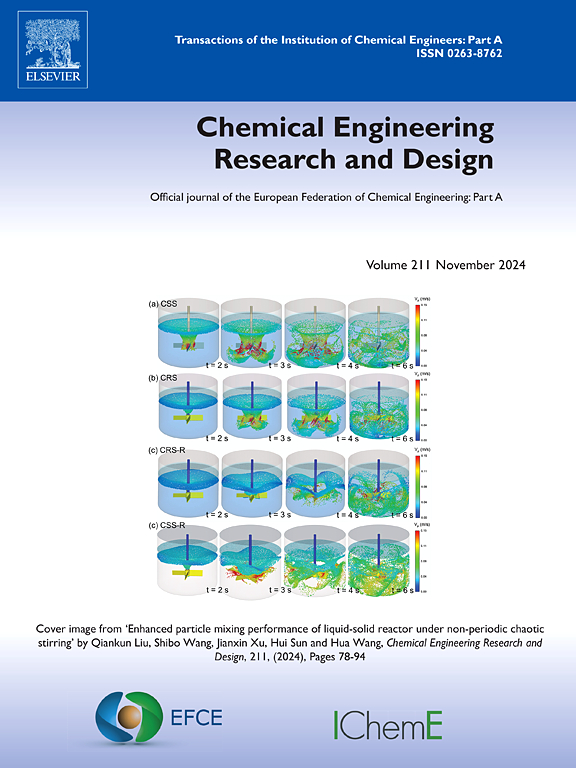Development of a new environmentally benign cascaded ammonia fuel generating system
IF 3.7
3区 工程技术
Q2 ENGINEERING, CHEMICAL
引用次数: 0
Abstract
Ammonia synthesis is recognized as a cornerstone of the chemical industry, yet it remains an energy-intensive process. As the demand for more efficient and sustainable production methods grows, this study designs an environmentally benign cascaded ammonia synthesis system, exploring three distinct configurations: single-stage, double-stage, and triple-stage cascaded systems. By implementing multiple reactors in series integrated with absorbent-enhanced separation (AES) technique, an effective solution is developed to eliminate the energy costs associated with gas recycling and minimize the number of recycle loops. A simplified AES model is developed using magnesium chloride (MgCl2) absorbent and assuming 90 % recovery factor that selectively binds to ammonia while ensuring continuous separation with minimal energy loss, preserving the pressure and temperature of the feed to the subsequent reactor. Through process simulations conducted with the Aspen Plus V11, our findings reveal that multi-stage configurations outperform single-stage synthesis, achieving higher energy efficiency and ammonia yield. The production capacity of single, double, and triple stage design comes out to be 1890 kg/day, 2640 kg/day, and 2800 kg/day. Additionally, the study incorporates sensitivity analyses, which elucidate the impact of various operational parameters on performance. The findings offer valuable insights for optimizing industrial-scale ammonia production while minimizing energy consumption and environmental impact.
新型环保级联氨燃料发电系统的研制
氨合成被认为是化学工业的基石,但它仍然是一个能源密集型的过程。随着对更高效和可持续生产方法的需求的增长,本研究设计了一个环境友好的级联氨合成系统,探索了三种不同的配置:单级,双级和三级级联系统。通过将多个反应器串联并集成吸收剂增强分离(AES)技术,开发了一种有效的解决方案,以消除与气体回收相关的能源成本,并最大限度地减少回收循环的数量。采用氯化镁(MgCl2)吸附剂建立了简化的AES模型,假设回收率为90 %,该模型可以选择性地与氨结合,同时以最小的能量损失确保连续分离,并保持后续反应器的进料压力和温度。通过使用Aspen Plus V11进行的过程模拟,我们的研究结果表明,多级合成优于单级合成,可以实现更高的能源效率和氨收率。单、双、三级设计的生产能力分别为1890 kg/天、2640 kg/天、2800 kg/天。此外,该研究还结合了敏感性分析,阐明了各种操作参数对性能的影响。这些发现为优化工业规模的氨生产,同时最大限度地减少能源消耗和环境影响提供了有价值的见解。
本文章由计算机程序翻译,如有差异,请以英文原文为准。
求助全文
约1分钟内获得全文
求助全文
来源期刊

Chemical Engineering Research & Design
工程技术-工程:化工
CiteScore
6.10
自引率
7.70%
发文量
623
审稿时长
42 days
期刊介绍:
ChERD aims to be the principal international journal for publication of high quality, original papers in chemical engineering.
Papers showing how research results can be used in chemical engineering design, and accounts of experimental or theoretical research work bringing new perspectives to established principles, highlighting unsolved problems or indicating directions for future research, are particularly welcome. Contributions that deal with new developments in plant or processes and that can be given quantitative expression are encouraged. The journal is especially interested in papers that extend the boundaries of traditional chemical engineering.
 求助内容:
求助内容: 应助结果提醒方式:
应助结果提醒方式:


